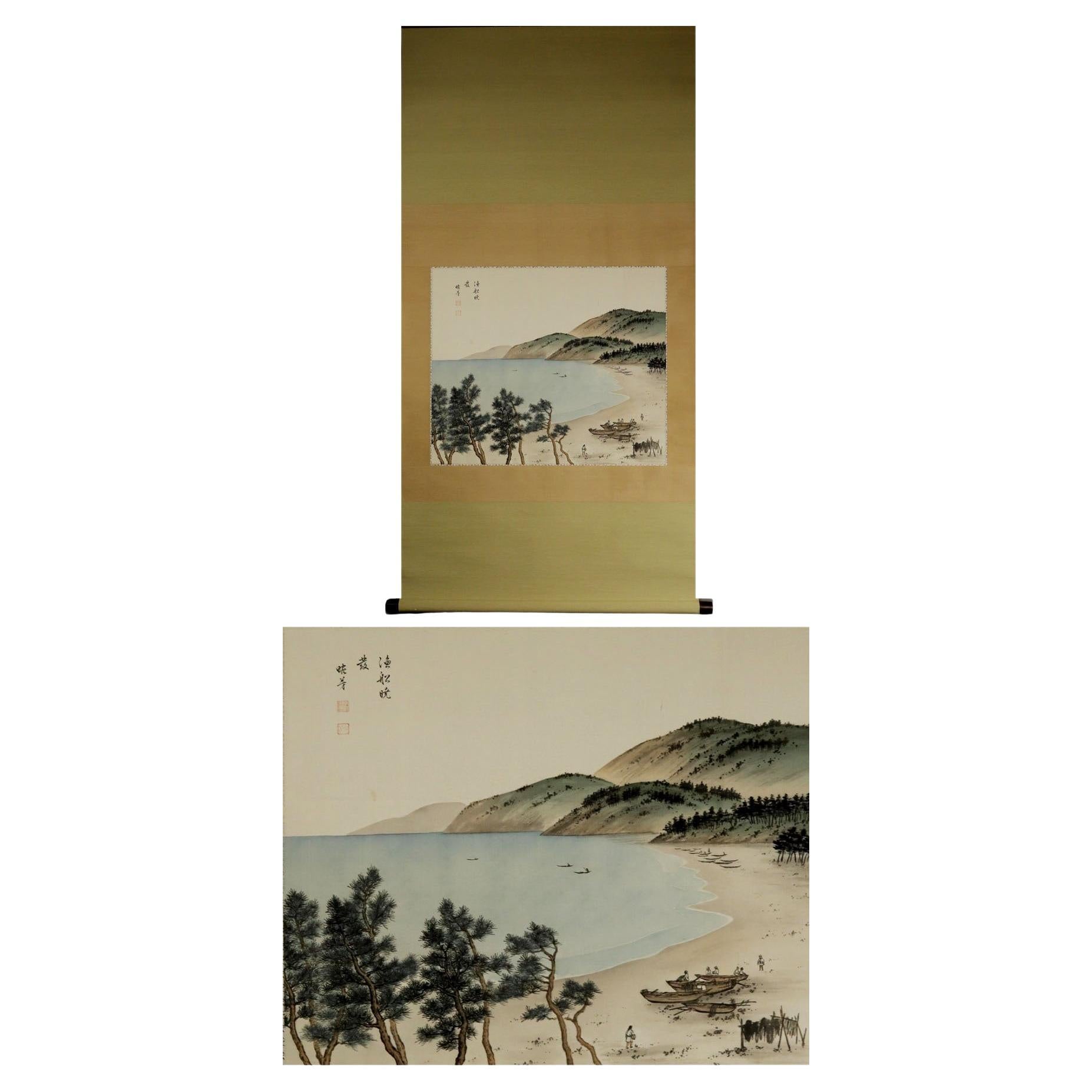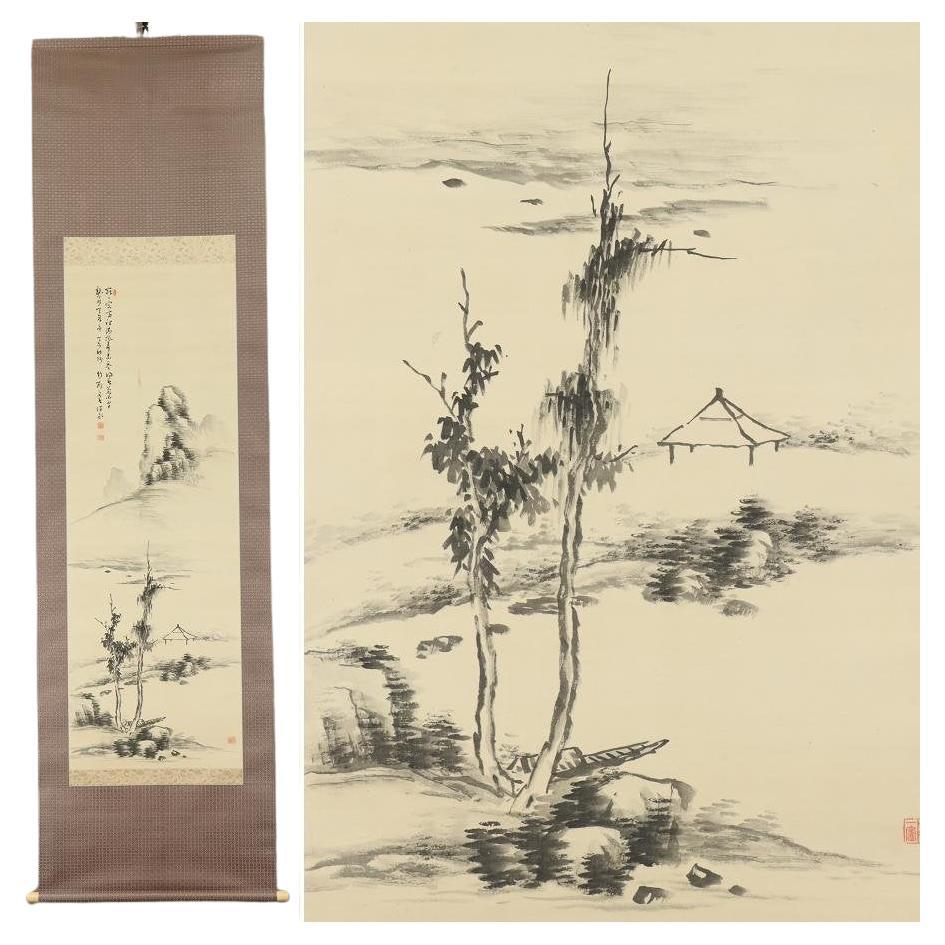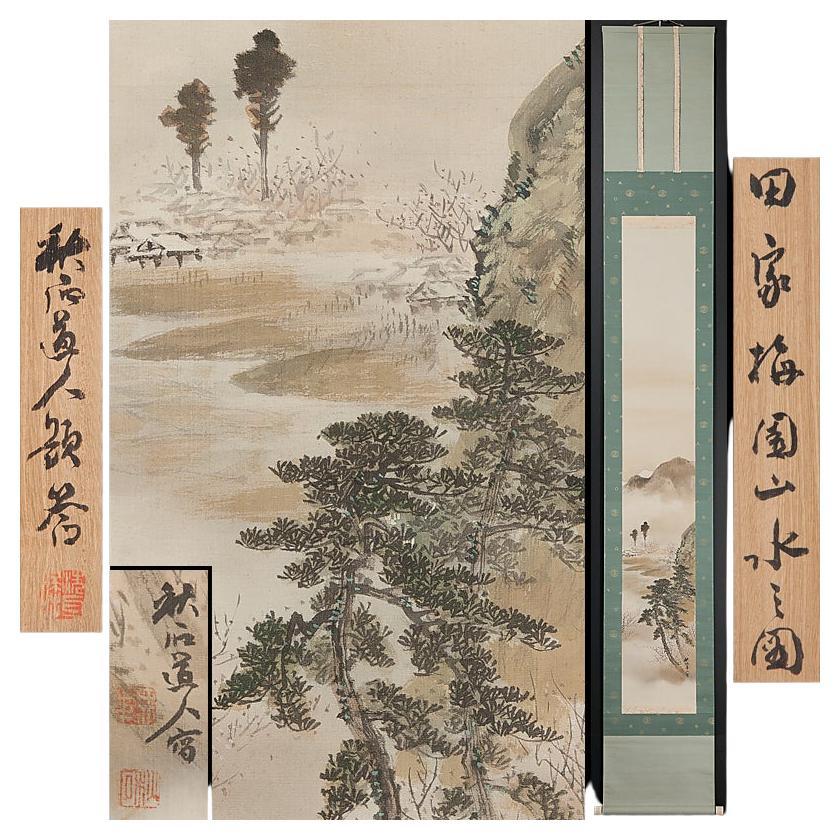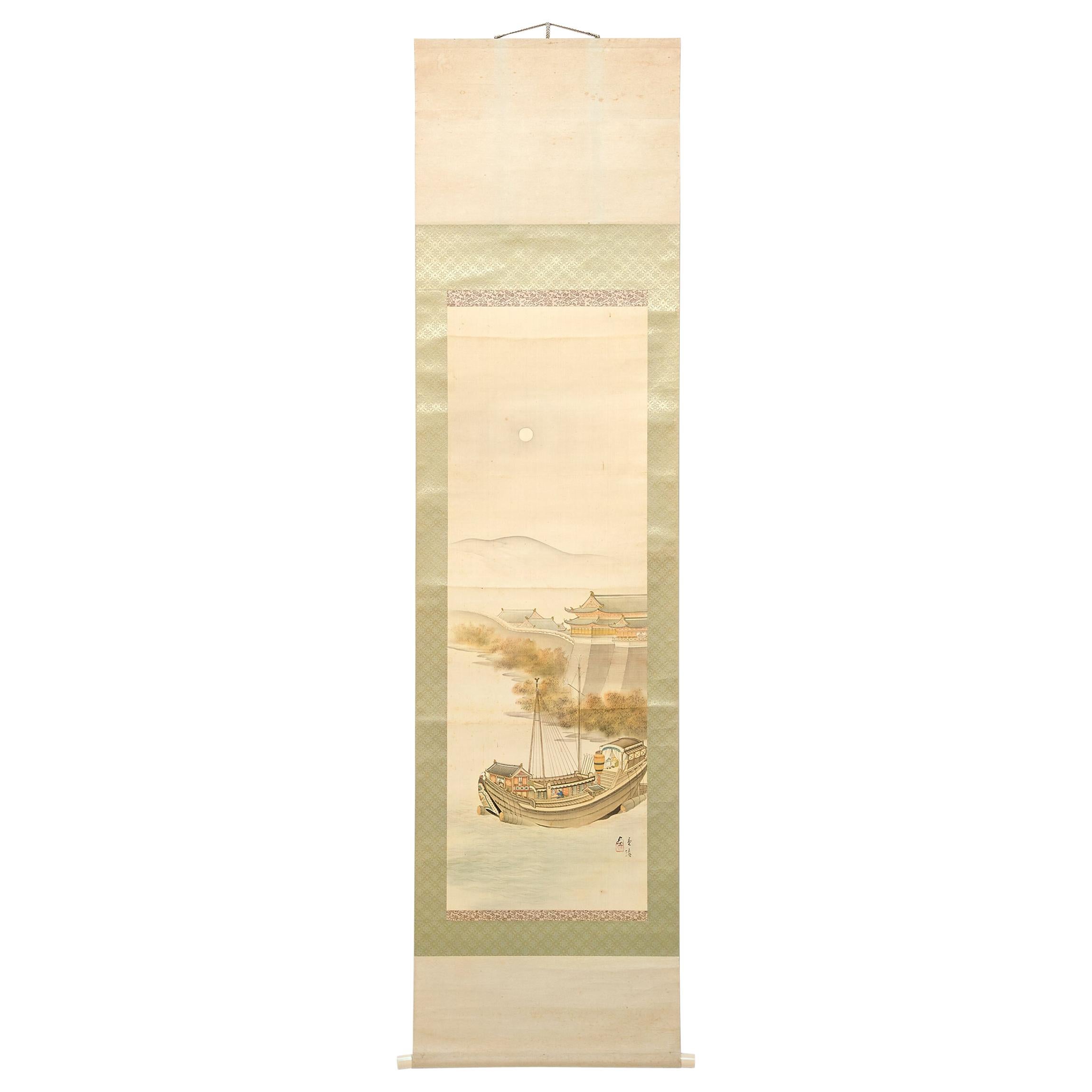Items Similar to Nihonga Japanese Painting 1900 Meiji Scroll Kawai Gyokudo Nanga School Lake Scen
Want more images or videos?
Request additional images or videos from the seller
1 of 7
Nihonga Japanese Painting 1900 Meiji Scroll Kawai Gyokudo Nanga School Lake Scen
About the Item
This painting by Gyokudo Kawa is named "Lakeside Night Return", portraying a serene journey home.
Gyokudo Kawai
(1873-1957)
A Japanese painter from the Meiji to Showa periods, born in Aichi Prefecture. Gyokudo Kawai, also known as Yoshizaburo, developed a unique style blending the Shijo and Kano schools. Notable for winning the first prize at the Tokyo Prefectural Industrial Exhibition in 1908, he served as a Bunten judge and a professor at the Tokyo School of Fine Arts.
Details:
Dimensions:
Axis: Approx. 126.0cm x 66.0cm
Paper: Approx. 30.0cm x 53.0cm
Condition:
In good condition, showcasing Gyokudo Kawai's artistry.
Inscriptions:
Includes inscriptions and details.
Box:
Comes with a protective box.
- Dimensions:Height: 49.61 in (126 cm)Width: 25.99 in (66 cm)Depth: 0.04 in (1 mm)
- Style:Meiji (Of the Period)
- Materials and Techniques:
- Period:
- Date of Manufacture:ca 1900
- Condition:Wear consistent with age and use.
- Seller Location:Amsterdam, NL
- Reference Number:
About the Seller
5.0
Gold Seller
These expertly vetted sellers are highly rated and consistently exceed customer expectations.
Established in 2015
1stDibs seller since 2019
158 sales on 1stDibs
Typical response time: 9 hours
- ShippingRetrieving quote...Ships From: Amsterdam, Netherlands
- Return PolicyA return for this item may be initiated within 14 days of delivery.
More From This SellerView All
- Nihonga Japanese Painting 1900 Meiji Scroll Fishing Boats at Gyosen Nanga SchoolLocated in Amsterdam, Noord HollandA drawing of the painting "Gyosen Gyosan" painted by Akifoshi. Also included is the box. This is a tasteful work depicting a fishing boat going fishing at sunrise. ■Silk back, handp...Category
Antique 19th Century Meiji Paintings
MaterialsSilk
- Japanese Nihonga Painting 19th Meiji Scroll Tajika Chikuson Landscape NangaLocated in Amsterdam, Noord Holland[Authentic Artwork] ◆ Chikuson Tajika ◆ Autumn Landscape ◆ Master: Naoiri Tanomura ◆ Oita Prefecture ◆ Hand-Painted ◆ Silk Mounted ◆ Hanging Scroll ◆ Delve into the artistry of Chik...Category
Antique 19th Century Edo Paintings
MaterialsSilk
- Japanese Nihonga Painting 1900 Meiji/Taisho Scroll Shûseki, Okutani LandscapeLocated in Amsterdam, Noord HollandSusheki Okutani "Takaya Plum Garden Landscape" Silk, Colored, Authentic, Hanging Scroll, , Double Box size Axis: Height 206.5cm Width 29.3cm Drawing…Height 126.7cm Width 19.5cm *There may be slight differences in dimensions. Thank you for your understanding. situation It is in good condition, but please note that there are some light stains. Please check the image for details. Thank you for your support. Biography Akishi Okutani Japanese painter. Born in Osaka. His name is Tsunejiro. He studied under Kansai Mori. From an early age, he exhibited his works at the Japan Painting Association and the Young People's Painting Association, which was led by Gaho Hashimoto and Gyokusho Kawabata, and won numerous awards. He also opened a private school...Category
20th Century Taisho Paintings
MaterialsSilk
- Artists Kawai Gyokudō Showa Period Scroll Japan 20c Artist NihongaLocated in Amsterdam, Noord HollandKawai Gyokudo (?? ??, November 24, 1873-June 30, 1957) was the pseudonym of a Japanese painter in the Nihongo school, active from Meiji through Showa period Japan. His real name was Kawai Yoshisaburo. Contents Biography Gyokudo was born in what is now Ichinomiya city, Aichi Prefecture, as the eldest son of a paper, ink and brush merchant. He went to Kyoto in 1887 to study under Kono Bairei of the Maruyama-Shijo school of painting. In 1896, he moved to Tokyo and he became the student of Hashimoto Gaho, of the Kano school. He also studied Western-style painting and developed a highly personal style, especially in the field of landscape painting. Gyokudo is noted for his polychrome and occasionally monochrome works depicting the mountains and rivers of Japan in the four seasons, with humans and animals shown as part of the natural landscape. Among his representative works are Futsuka zuki (“The New Moon”), Yuku haru (“The Departing Spring”), Mine-no-yu (“Evening at the Mountain Top”), and Bosetsu (“Snow in the Evening”). In 1898, Gyokudo joined with Okakura Tenshin and Yokoyama Taikan...Category
20th Century Japanese Taisho Paintings and Screens
MaterialsSilk
- Artists Kawai Gyokudō Showa Period Scroll Japan 20c Artist NihongaLocated in Amsterdam, Noord HollandKawai Gyokudo (?? ??, November 24, 1873-June 30, 1957) was the pseudonym of a Japanese painter in the Nihongo school, active from Meiji through Showa period Japan. His real name was Kawai Yoshisaburo. Contents Biography Gyokudo was born in what is now Ichinomiya city, Aichi Prefecture, as the eldest son of a paper, ink and brush merchant. He went to Kyoto in 1887 to study under Kono Bairei of the Maruyama-Shijo school of painting. In 1896, he moved to Tokyo and he became the student of Hashimoto Gaho, of the Kano school. He also studied Western-style painting and developed a highly personal style, especially in the field of landscape painting. Gyokudo is noted for his polychrome and occasionally monochrome works depicting the mountains and rivers of Japan in the four seasons, with humans and animals shown as part of the natural landscape. Among his representative works are Futsuka zuki (“The New Moon”), Yuku haru (“The Departing Spring”), Mine-no-yu (“Evening at the Mountain Top”), and Bosetsu (“Snow in the Evening”). In 1898, Gyokudo joined with Okakura Tenshin and Yokoyama Taikan...Category
20th Century Japanese Taisho Paintings and Screens
MaterialsSilk
- Kawai Gyokudō Nihonga Scene Early 20th Century Scroll Painting Japan ArtistLocated in Amsterdam, Noord HollandIt is a high-quality craft of the work drawn by Kawai Gyokudo as you can see. It creates a texture that makes you feel a refreshing breeze, and it is a tasty work that is carefully drawn even to lush bushes and trees. (A guidebook (bookmark) is also included.) "Kawaai Gyokudo" [1873-1957] Japanese painter. Born in Aichi. His real name is Hosaburo. Another issue, Ikuan. At the beginning, he studied under the Shijo school and then Masakuni Hashimoto to study the Kano school, and established his own style as a moderate landscape painting full of poetry. Received the Order of Culture. Work "Ayaame" etc. ¦ Paper books and crafts. ¦ The condition is beautiful. ¦ Axial dimension/approx. 128.0 cm x 62.0 cm. ¦ Paper size/approx. 40.5 cm x 51.0 cm. ¦ Incorporation/There are inscriptions/incorporations as you see. ¦ Box/Box. awai Gyokudo (?? ??, November 24, 1873 – June 30, 1957) was the pseudonym of a Japanese painter in the nihonga school, active from Meiji through Showa period Japan. His real name was Kawai Yoshisaburo. Contents Biography Gyokudo was born in what is now Ichinomiya city, Aichi Prefecture, as the eldest son of a paper, ink and brush merchant. He went to Kyoto in 1887 to study under Kono Bairei of the Maruyama-Shijo school of painting. In 1896, he moved to Tokyo and he became the student of Hashimoto Gaho, of the Kano school. He also studied Western-style painting and developed a highly personal style, especially in the field of landscape painting. Gyokudo is noted for his polychrome and occasionally monochrome works depicting the mountains and rivers of Japan in the four seasons, with humans and animals shown as part of the natural landscape. Among his representative works are Futsuka zuki (“The New Moon”), Yuku haru (“The Departing Spring”), Mine-no-yu (“Evening at the Mountain Top”), and Bosetsu (“Snow in the Evening”). In 1898, Gyokudo joined with Okakura Tenshin and Yokoyama Taikan...Category
Early 20th Century Japanese Taisho Paintings and Screens
MaterialsSilk
You May Also Like
- Japanese Meiji Riverside Scroll Painting, c. 1900Located in Chicago, ILAlthough western painting was initially embraced during Japan’s Meiji period (1868-1912), artists brought on a revival of traditional painting styles as they sought to create a modern Japanese style with roots in the past. This exquisite hanging scroll demonstrates the preference for soft layering of gray tones with judicious use of color. The landscape is rendered in soft ink washes that subtly distinguish between water, mountain, and sky. The scroll painting...Category
Early 20th Century Japanese Meiji Paintings and Screens
MaterialsPaper
- 19th Century Japanese Shunga Hand-Scroll, Katsukawa SchoolLocated in Kyoto, JPShunga Unknown artist Meiji era, circa 1880 Hand-scroll mounted with 12 paintings Ink, pigment and gofun on silk Dimensions: Each image measures H. 23.2 cm x W. 34.4 cm (9.15” x 13.5”) The hand-scroll measures H. 28 cm x W. 540 cm (11” x 212”) A set of 12 late 19th century Japanese Shunga paintings mounted as a hand-scroll. Two of the leaves bear the signature and seal ‘Setsuzan’, although we are unable to confirm the identity of the artist using this art name. 6 of the 12 images are taken almost directly from Katsukawa Shuncho’s late 18th century woodblock series, ‘Erotic Pictures...Category
Antique Late 19th Century Japanese Meiji Paintings and Screens
MaterialsSilk
- Japanese Silver Screen Pair, Meiji Period, Herons & Plovers, Shijo SchoolLocated in Kyoto, JPHeron & Plovers Ink and silver leaf on paper Maekawa Bunrei (1837-1917) A pair of low six-panel Japanese screens by Maekawa Bunrei, a later master of the Kyoto based Shijo school of painting. On the right screen a solitary white heron stands motionless in a stream. On the left screen plovers play along a shoreline. The elegant forms are executed employing fluid, minimalistic ink brushstrokes. The soft brushstrokes and the sharp light of the silver leaf lend the scenes a sense of translucence. The sophisticated composition superbly exploits the long, horizontal pictorial surface of the pair of folding screens...Category
Antique Early 1900s Japanese Meiji Paintings and Screens
MaterialsSilver Leaf
- Antique hanging scroll of Japanese cat/Late Edo-Meiji period/Cat paintingLocated in Sammu-shi, ChibaThis is a picture of a cat drawn by a person named "Toshizumi Nitta" from the end of the Edo period to the beginning of the Meiji period. She is a very simple and cute cat. He is a vassal of the Tokugawa Shogunate, born in Ota City, Gunma Prefecture (southern part of Gunma Prefecture). He was related to the Tokugawa family and lived in a large mansion in the Ota clan in Gunma prefecture. However, the Nitta family's territory was very small, and they were by no means a wealthy vassal. He seems to have lived quite poorly. So he painted cats and sold them to people. The Nitta family continued to draw pictures of this cat for four generations. "Nitta toshizumi" is equivalent to the fourth generation. During the Edo period, sericulture was thriving in the Kanto region. Cats were said to be the gods of silkworms, as they drive away mice, the natural enemies of silkworms. It was the Nitta family who drew such a cat on paper, pasted it in the silkworm chamber, and sold it as a mouse repellent. There were also other monks who painted pictures of cats, but the Nitta family in particular was related to the Tokugawa family, so people believed that paintings of cats had special powers. , a lot of paintings...Category
Antique Late 19th Century Japanese Edo Paintings
MaterialsPaper
- Meiji Era, Circa 1900 Japanese Screen Pair, Flowers & Birds of Spring & AutumnLocated in Kyoto, JPFlowers & Birds of Spring and Autumn Unknown artist. Japan. Meiji period, circa 1900. A pair of six-fold screens. Ink, color, gofun and gold leaf on paper. Signed: Gaga S...Category
Antique 1890s Japanese Meiji Paintings and Screens
MaterialsGold Leaf
- Robert Crowder Signed 5 Panel Large Japanese Nihonga Lanscape Pastoral PaintingBy Robert CrowderLocated in Studio City, CAA beautiful, engaging, original, and quite rare work of art by American artist Robert Crowder (1911-2010). Crowder lived in Japan in the 1930s (u...Category
Vintage 1960s American Mid-Century Modern Paintings
MaterialsWood, Paint, Paper




![Lovely Japanese 20th c Scroll by Gyokudo Kawai [1873-1957] Autumn Landscape](https://a.1stdibscdn.com/lovely-japanese-20th-c-scroll-by-gyokudo-kawai-1873-1957-autumn-landscape-for-sale/f_48632/f_368836321698848564735/f_36883632_1698848565061_bg_processed.jpg)
![Lovely Japanese 20th c Scroll by Gyokudo Kawai [1873-1957] Horai Landscape](https://a.1stdibscdn.com/lovely-japanese-20th-c-scroll-by-gyokudo-kawai-1873-1957-horai-landscape-for-sale/f_48632/f_368840321698849126985/f_36884032_1698849127429_bg_processed.jpg)